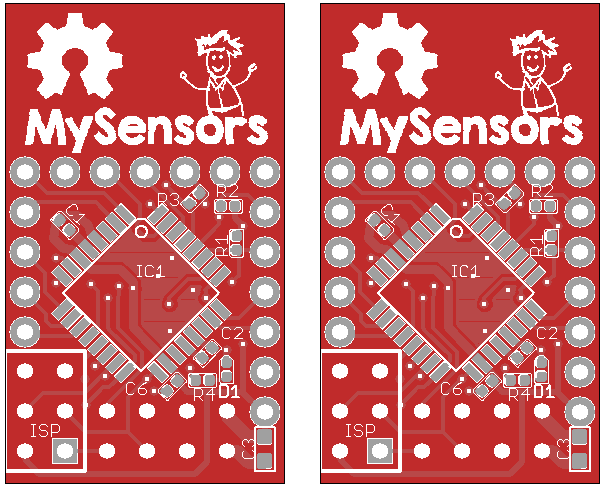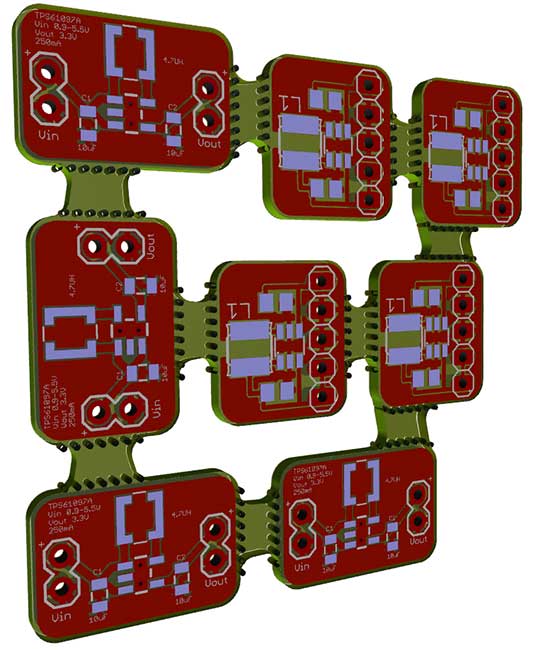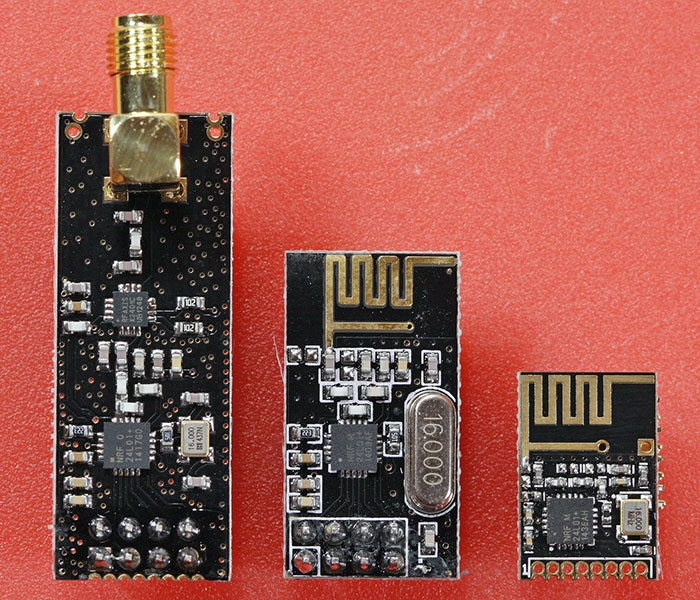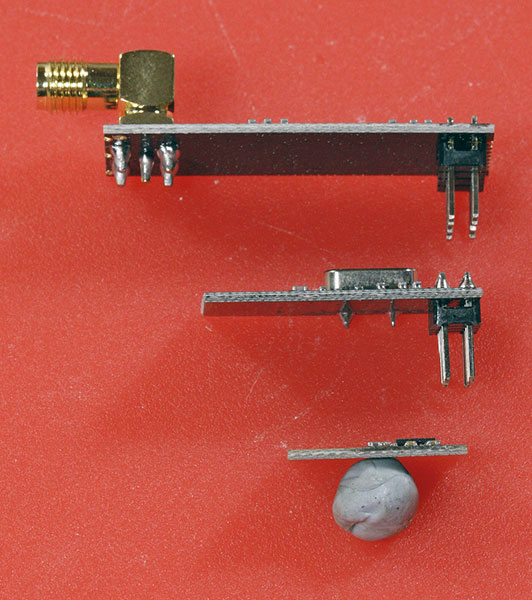Minimal design thoughts
-
And pcb's are ordered.. Again, using dirtypcbs.com, for the order..
I have used a panelizer tool from http://blog.thisisnotrocketscience.nl/ to panelize the boards this time, so it should be easier to depanelize it when they get here..

@tbowmo Looks great!
Haven't actually ordered anything produced by the panelizer yet, but the results look really amazing:

I was planning to finally get around to some boost regulators. But I need to design mine from scratch (these are just scavenged from other places) so they follow the same design guide lines and can be plugged in seamlessly to the main pcb.
Would be great if there were some sort of common design to follow for designing shields and such.
-
As you all probably have noticed, there is an mysensor logo on the boards, that I just ordered.. :)
I have been cooperating with @hek for a while, and this is going to be an "official Mysensor pcb" :)
We have been in discussions with a vendor in china, for doing SMT assembly as well.. We are currently waiting for the pcb's to arrive and get them populated, to verify that everything is as it should be, before we start up production in China.
For a batch of 100 units, the price is about 13$ per unit, plus shipping/handling fee, this is without any profits to the project
One question though, I made room for an ATSHA204 chip on the board, that could be used for authentication purposes, we want to know if this should be mounted as default on the board, as it will add arround 1$ to the unit price.
Also how many would be interested in ordering one (or 10, 20, 50?) of them? :) (just so that we get an indication if we should make a batch of 100 units, or 500 units)
-
As you all probably have noticed, there is an mysensor logo on the boards, that I just ordered.. :)
I have been cooperating with @hek for a while, and this is going to be an "official Mysensor pcb" :)
We have been in discussions with a vendor in china, for doing SMT assembly as well.. We are currently waiting for the pcb's to arrive and get them populated, to verify that everything is as it should be, before we start up production in China.
For a batch of 100 units, the price is about 13$ per unit, plus shipping/handling fee, this is without any profits to the project
One question though, I made room for an ATSHA204 chip on the board, that could be used for authentication purposes, we want to know if this should be mounted as default on the board, as it will add arround 1$ to the unit price.
Also how many would be interested in ordering one (or 10, 20, 50?) of them? :) (just so that we get an indication if we should make a batch of 100 units, or 500 units)
That's 2 questions... :-)
- Yes, It's worth it to me (Hopefully there will be MySensors software support down the road)
- I would probably start off with 3 to 5.
Will there be a "kit" price for those who want to populate and reflow themselves?
-
As you all probably have noticed, there is an mysensor logo on the boards, that I just ordered.. :)
I have been cooperating with @hek for a while, and this is going to be an "official Mysensor pcb" :)
We have been in discussions with a vendor in china, for doing SMT assembly as well.. We are currently waiting for the pcb's to arrive and get them populated, to verify that everything is as it should be, before we start up production in China.
For a batch of 100 units, the price is about 13$ per unit, plus shipping/handling fee, this is without any profits to the project
One question though, I made room for an ATSHA204 chip on the board, that could be used for authentication purposes, we want to know if this should be mounted as default on the board, as it will add arround 1$ to the unit price.
Also how many would be interested in ordering one (or 10, 20, 50?) of them? :) (just so that we get an indication if we should make a batch of 100 units, or 500 units)
-
That's 2 questions... :-)
- Yes, It's worth it to me (Hopefully there will be MySensors software support down the road)
- I would probably start off with 3 to 5.
Will there be a "kit" price for those who want to populate and reflow themselves?
@ServiceXp said:
That's 2 questions... :-)
I edited it a couple of times while talking with @hek last evening, so it slipped. Hope you can forgive me ;)
- Yes, It's worth it to me (Hopefully there will be MySensors software support down the road)
- I would probably start off with 3 to 5.
Will there be a "kit" price for those who want to populate and reflow themselves?
No kit version, the pcb will be released under oshw so you could order it yourself, and source the components. However my unit price for the initial units will hit 11-12$, so it's only 1 or 2$ extra to get it smt assembled in China.
The more units we can order the cheaper it will become.
-
@ServiceXp said:
That's 2 questions... :-)
I edited it a couple of times while talking with @hek last evening, so it slipped. Hope you can forgive me ;)
- Yes, It's worth it to me (Hopefully there will be MySensors software support down the road)
- I would probably start off with 3 to 5.
Will there be a "kit" price for those who want to populate and reflow themselves?
No kit version, the pcb will be released under oshw so you could order it yourself, and source the components. However my unit price for the initial units will hit 11-12$, so it's only 1 or 2$ extra to get it smt assembled in China.
The more units we can order the cheaper it will become.
@tbowmo I might be interested in a few, seeing as this PCB has some pretty unique features, but I'm still in the market for a board with an on-board regulator that will give me a bit more flexibility.
The problem (for me) is that while waiting for any official hardware, I've bought a lot of other stuff. I had another 10x Arduino Pro Mini arrive just yesterday for instance. Plus the booster project above. I ordered a couple of hundred brand inductors and capacitors as well as ltc3525 ICs. So basically now I don't have a choice but to go it alone for the most part :sweat:
What we could need right now is some clear direction, like whether the ATSHA204 is the way to go. Or some common form factor that would allow future shields or whatnot.
Also, for something really small like this, to be put into production, I would have liked to have tried with the "smd / mini nrf24" version that is also available on Ebay, just to keep the size down even further. I just got three of those yesterday and they are indeed very tiny (pin header spacing is 1.27mm). Whether they work ok or not I do not know. I do know that some people on the forum have posted project pictures with these mini nrf24. I guess what I'm saying is that lowpowerlabs already invented the wheel here: http://lowpowerlab.com/moteino/
Would be great to hang a mini nrf24 flat off of the back if at all possible. But given what we know of the nrf24 it would probably blow up in our faces compared to the RFM12B/RFM69 that the moteino uses. Of course, they also use a wire antenna while we still trust the pcb antenna ... -
@tbowmo I might be interested in a few, seeing as this PCB has some pretty unique features, but I'm still in the market for a board with an on-board regulator that will give me a bit more flexibility.
The problem (for me) is that while waiting for any official hardware, I've bought a lot of other stuff. I had another 10x Arduino Pro Mini arrive just yesterday for instance. Plus the booster project above. I ordered a couple of hundred brand inductors and capacitors as well as ltc3525 ICs. So basically now I don't have a choice but to go it alone for the most part :sweat:
What we could need right now is some clear direction, like whether the ATSHA204 is the way to go. Or some common form factor that would allow future shields or whatnot.
Also, for something really small like this, to be put into production, I would have liked to have tried with the "smd / mini nrf24" version that is also available on Ebay, just to keep the size down even further. I just got three of those yesterday and they are indeed very tiny (pin header spacing is 1.27mm). Whether they work ok or not I do not know. I do know that some people on the forum have posted project pictures with these mini nrf24. I guess what I'm saying is that lowpowerlabs already invented the wheel here: http://lowpowerlab.com/moteino/
Would be great to hang a mini nrf24 flat off of the back if at all possible. But given what we know of the nrf24 it would probably blow up in our faces compared to the RFM12B/RFM69 that the moteino uses. Of course, they also use a wire antenna while we still trust the pcb antenna ...@bjornhallberg said:
@tbowmo I might be interested in a few, seeing as this PCB has some pretty unique features, but I'm still in the market for a board with an on-board regulator that will give me a bit more flexibility.
The problem (for me) is that while waiting for any official hardware, I've bought a lot of other stuff. I had another 10x Arduino Pro Mini arrive just yesterday for instance. Plus the booster project above. I ordered a couple of hundred brand inductors and capacitors as well as ltc3525 ICs. So basically now I don't have a choice but to go it alone for the most part :sweat:
What we could need right now is some clear direction, like whether the ATSHA204 is the way to go. Or some common form factor that would allow future shields or whatnot.
Also, for something really small like this, to be put into production, I would have liked to have tried with the "smd / mini nrf24" version that is also available on Ebay, just to keep the size down even further. I just got three of those yesterday and they are indeed very tiny (pin header spacing is 1.27mm). Whether they work ok or not I do not know. I do know that some people on the forum have posted project pictures with these mini nrf24. I guess what I'm saying is that lowpowerlabs already invented the wheel here: http://lowpowerlab.com/moteino/
Would be great to hang a mini nrf24 flat off of the back if at all possible. But given what we know of the nrf24 it would probably blow up in our faces compared to the RFM12B/RFM69 that the moteino uses. Of course, they also use a wire antenna while we still trust the pcb antenna ...I forgot about the mini nrf24 modules. But I don't think that we could have squeezed it that much more in size, we could probably save 2-3mm in stack height, but that's about it.
Also, this board was designed from the beginning to be a battery operated node. That is why there is no regulator on board (besides the fact that there is no room for it). I selected the components for their ability to work on low voltages all, except the atsha204, is able to work on a VCC as low as 1.8V)
I have seen lot's of questions asking about battery operation of 3.3V arduino mini pro, with DHT22 sensors attached. People cut LED's and regulators on the arduino, in order to get the power consumption as low as possible. This is where this particular board fits in. It's ready for battery operation, and has the temperature / humidity sensor build in.
It started out because I wanted an "easy" clean option for sensor nodes for my own application, without any wire nests between arduino and nrf24 modules. I hope that it will be useful for others as well, and might be able to get others going with the mysensor project.
For my own part, I could use up to 20 of these, for measuring temperature / humidity in every room in the house (and out side as well)
Btw. all those arduinos you've bought, could be turned into something else :)
-
I snapped some pictures just so everyone can see the difference between the nrf24 modules.


Of course, like I said, I don't even know if the "mini" works in a satisfactory manner. I'm gonna get some smaller pitch headers so I can make a prototype. But the PCB antenna actually seems to be the exact same size so I have high hopes for that aspect at least. -
The antenna still needs to hang over "free air" (or an unrouted PCB area), this is the area where the logo is located on the current design. It could be moved to the opposite end of the pcb (where the nrf24 pinheader is located).
If we switch to the mini module, then the pinheader for the radio is removed, but then you need a "larger" area where there is no components at all, in order to mount the nrf module flat to the sensor pcb. So in theory it will not be that much smaller, only the pinheader distance between the two pcbs can be removed.. lenght /width will be almost the same, maybe a bit longer as there is not that much room to give, with the current number of components (Si7021, eeprom, atsha204 etc).
-
The antenna still needs to hang over "free air" (or an unrouted PCB area), this is the area where the logo is located on the current design. It could be moved to the opposite end of the pcb (where the nrf24 pinheader is located).
If we switch to the mini module, then the pinheader for the radio is removed, but then you need a "larger" area where there is no components at all, in order to mount the nrf module flat to the sensor pcb. So in theory it will not be that much smaller, only the pinheader distance between the two pcbs can be removed.. lenght /width will be almost the same, maybe a bit longer as there is not that much room to give, with the current number of components (Si7021, eeprom, atsha204 etc).
@tbowmo Yeah, you're probably right. It would take some re-design and you might not save all that much space, given all the other components as you say.
Still, it'd be great to achieve something ... flatter ... like:
http://harizanov.com/2014/07/diy-internet-of-things-fire-alarm/
Runs an attiny84 though, but still. -
Could you measure the mini pcb? the width of the module, and lenght of the area with gnd, and the length of the antenna area (and total length of the module, should be the two lengths added together)
@tbowmo I found an old post I made here:
http://forum.mysensors.org/topic/413/is-there-a-schematic-of-the-nrf24-board/2
I checked the measurements and they seem right. In addition, the antenna-area is about 8mm long. -
made a mockup of the nrf24 mini module, and tried to place it on the sensor board.. If I should use it, I have to remove the ISP pinheader from the board, as there is no room for it.
Also, it is filling up almost half the populated pcb area on the sensor board, which means that there is not enough space for the components, and we have to make a bigger pcb, in order to have room for everything.
-
made a mockup of the nrf24 mini module, and tried to place it on the sensor board.. If I should use it, I have to remove the ISP pinheader from the board, as there is no room for it.
Also, it is filling up almost half the populated pcb area on the sensor board, which means that there is not enough space for the components, and we have to make a bigger pcb, in order to have room for everything.
@tbowmo Yeah, better to save it for a future project. I mean, there will never be a one size fits all and that is what is so great about MySensors. All the PCBs designed so far have a purpose and a market. And ideally, we'd want a few of each in the sensor network to complement each other.
The reason I brought up the "mini", aside from wanting a flatter sensor node, is that the module seems to be getting more common on Ebay as well as cheaper. I've seen some sellers that sell them for the same price as the regular NRF24 now (in 10pcs). Four months ago, they were rare and many times more expensive. So if they work as advertised they could soon replace the NRF24 module we've all come to use.
In this context, and knowing very little of antennas, it is too bad they don't have a version without the PCB antenna altogether. We could add our own antennas and more easily fit the module on miniscule sensor nodes such as yours.
-
@tbowmo
Sorry I was a bit unclear. I would like to buy all components as a package from you/mysensors. Preferably assembled, but I would also accept if you sell it unassembled (pcb+components). I would rather not have to source the components myself :)Btw, have you measured the actual power consumption? Sleep vs temp/hum measurement?
-
I haven't measured supply current, as I don't have the equipment to do that. I am looking at getting the uCurrent gold from eevblog, but it's expensive to import it to Denmark.
It will probably not be offered as a kit. Too much work from my/our part :-)
